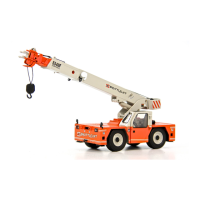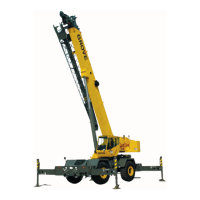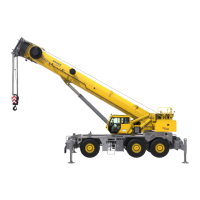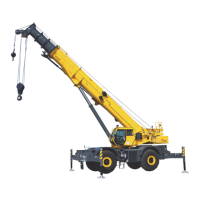8-2
Published 01-29-2014, Control # 496-00
UNDERCARRIAGE TMS800E SERVICE MANUAL
Each front axle is bolted to the walking beam of the
suspension system. Each axle is anchored against forward,
rearward, and side ways movement by adjustable torque
rods attached to the axles and to brackets on the carrier
frame.
Suspension
The front axle suspension uses air bags with walking beams.
The air bags along with shock absorbers are mounted on
saddle assemblies above the walking beams. They provide
for cushioning of road shock. The saddle assemblies are
connected at the front by pivot blocks to carrier mounted
brackets. The air bags and shock absorbers are bolted to the
rear of the saddle assemblies and to carrier mounted
brackets. A walking beam center is attached to each saddle
assembly with the ends attached to each front axle.
Rubber bushings in the walking beam centers and ends, and
torque rod ends, restrict excessive movement but allows
enough movement to relieve stresses on metal parts. The
rubber joints allow a certain amount of in and out axle
movement which permits each axle to follow its own natural
course more closely through turns. Once a straight line is
resumed, the bushings square off the tandem so that the
leading tires set the tracking pattern. Torque rods along with
the walking beam creates a parallelogram style linkage that
assure positive axle alignment.
Air for the suspension system is controlled by a control valve
on the side console in the carrier cab and by two height
control valves mounted on each side of the frame by the air
bags. Each height control valve is mechanically actuated by
a control lever attached to its respective saddle assembly.
The valve controls the amount of air in each set of air bags
thus controlling the height of the frame. When the ignition
switch is OFF and the crane is on rubber, the air bags will
inflate. To deflate the entire air suspension system (front and
rear), position the inflation control switch on the carrier cab
right side panel to the right to deflate. This causes the four
height control valves to shift and dump all air from the
suspension air bags. Four pressure switches sense the air
pressure in each set of air bags. Low air pressure in any of
the four sets of air bags will trip the respective pressure
switch to illuminate the suspension deflated indicator on the
right side console.
Maintenance
NOTE: For more information on the axles, refer to Volume
2 - Service Maintenance Manual or the
Arvinmeritor web site.
General
Proper preventive maintenance will help control repair costs
and downtime. If a major overhaul is required, remove the
tandem suspension and axle assemblies from the carrier.
However, torque rods, air bags, shock absorbers, walking
beams, and other components can be removed separately
as required with the axles remaining on the carrier. Refer to
Lubrication, page 9-1 for specified lubrication intervals.
Check the torque on all bolts at least once a year.
Beam Center Cap Fasteners
Periodically check the bolts on the saddle cap to prevent
wear of the beam center bushing into the saddle assembly.
Check that bolt torque is 305 to 372 Nm (225 to 275 ft-lb).
Beam End Connections and Bushings
Every 16,090 km (10,000 mi) check the torque of the beam
end bolts. Tighten to 610 to 813 Nm (450 to 600 lb-ft). Jack
up under each beam end and check for movement of the
rubber end bushing. Worn bushings will allow movement and
the bushings should be replaced. Periodically inspect the
beam for a lowering in the hanger and distorted or frayed
rubber. A gap on each side of the visible rubber at the lower
end of the end bushing is normal because the end bushings
are in compression.
Saddle Assembly End Cap Fasteners
Periodically check the bolt torque on the saddle assembly
end caps, 305 to 372 Nm (225 to 275 lb-ft).
Beam Center Bushings
The beam center bushings control lateral movement of the
axles during cornering. Normal wear is evidenced by rubber
shredding from each end of the bushing. Worn bushings
result in increased lateral movement on turns, causing the
inside walls of the tires to rub on the suspension saddle
assemblies during turns. Replace the bushings before
serious tire damage results.
Beam Center Cross Tube
The center cross tube connects the two walking beams and
maintains axle alignment in turns. Inspect the cross tube for
damage and, if bent, it must be replaced. A bent tube will
result in axle misalignment and cause abnormal tire wear.
Reference Only
